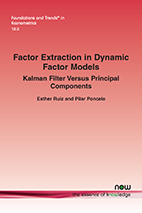Factor Extraction in Dynamic Factor Models: Kalman Filter Versus Principal Components
By Esther Ruiz, Universidad Carlos III de Madrid, Spain, ortega@est-econ.uc3m.es | Pilar Poncela, Universidad Autónoma de Madrid, Spain
Abstract
This survey looks at the literature on factor extraction in the context of Dynamic Factor Models (DFMs) fitted to multivariate systems of economic and financial variables. Many of the most popular factor extraction procedures often used in empirical applications are based on either Principal Components (PC) or Kalman filter and smoothing (KFS) techniques. First, we show that the KFS factors are a weighted average of the contemporaneous information (PC factors) and the past information and that the weights of the latter are negligible unless the factors are close to the non-stationarity boundary and/or their loadings are pretty small when compared with the variance-covariance matrix of the idiosyncratic components. Note that the weight of the past can be large either because the cross-sectional dimension is small or because the magnitude of the factor loadings is small. Consequently, we are able to explain why, in practice, there is a general consensus about PC and KFS factors being rather similar when extracted from stationary systems of large dimensions. Second, we survey how PC and KFS deal with several issues often faced in the context of extracting factors from real data systems. In particular, we describe PC and KFS procedures to deal with mixed frequencies and missing observations, structural breaks, non-stationarity, Markov-switching parameters or multi-level factor structures. In general, we see that KFS is very flexible to deal with these issues.
Factor Extraction in Dynamic Factor Models: Kalman Filter Versus Principal Components
Factor Extraction in Dynamic Factor Models: Kalman Filter Versus Principal Components surveys the literature on factor extraction in the context of Dynamic Factor Models (DFMs) fitted to multivariate systems of economic and financial variables. Many of the most popular factor extraction procedures often used in empirical applications are based on either Principal Components (PC) or Kalman filter and smoothing (KFS) techniques. First, the authors show that the KFS factors are a weighted average of the contemporaneous information (PC factors) and the past information and that the weights of the latter are negligible unless the factors are closed to the non-stationarity boundary and/or their loadings are pretty small when compared with the variance-covariance matrix of the idiosyncratic components. Second, the authors survey how PC and KFS deal with several issues often faced in the context of extracting factors from real data systems. In particular, they describe PC and KFS procedures to deal with mixed frequencies and missing observations, structural breaks, non-stationarity, Markov-switching parameters or multi-level factor structures. In general, KFS is very flexible to deal with these issues.
